
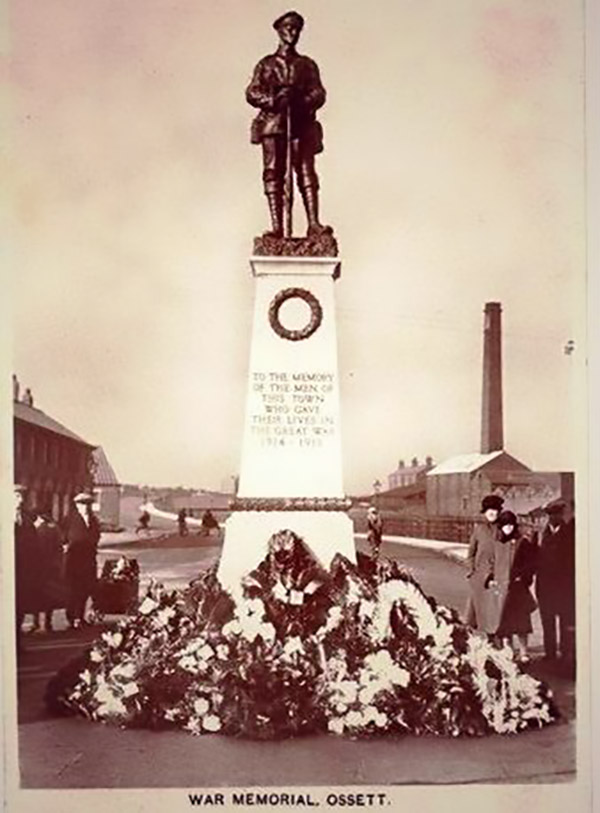
Researched and written by Alan Howe
The aftermath of the First World War saw the biggest single wave of public commemoration ever with tens of thousands of memorials erected across England. This was the result of both the huge impact on communities of the loss of three quarters of a million British lives, and also the official policy of not repatriating the dead which meant that the memorials provided the main focus of the grief felt at this great loss. One such memorial was raised at Ossett as a permanent testament to the sacrifice made by men from the town who lost their lives in the First World War.
In accordance with the Ministry of Justice (formerly the Department for Constitutional Affairs) Advice and Guidance2, organisations which are responsible for the custodianship of war memorials should ensure that the memorials are recognised as such and cared for in the future. The Ministry advises custodian organisations to search their own written or photographic records, together with publicly accessible records including local history libraries and records offices.
If there is no pre-existing record, those responsible are advised by the Ministry to keep a record of any war memorials in the custody of their organisation, and record details in a consistent fashion. Wakefield Metropolitan District Council is the owner and custodian of the Grade II listed Ossett War Memorial.
Since 2014 Ossett has seen significant changes to the status and importance of its War Memorial and biographies of The Ossett Fallen in WWI & WWII have been researched, written and published. The Ossett War Memorial Project, launched in 2017, saw the engraving in 2018 of the names of The Ossett Fallen on granite memorial stones set around the base of the Grade II listed Ossett War Memorial.
The history which follows this Introduction recognises the events of the Ossett Memorial since its distant beginnings in the 1920’s to its more recent adventures in marking the names of The Ossett Fallen so that they might be remembered in death as they were known in life; by their names.
Hostilities in The Great War 1914-1918 ceased when the Armistice was signed at 11a.m. on 11th November 1918. Even before that historic day Ossett was considering how it might remember the Ossett Fallen. Suggestions ranged from a Memorial or Roll of Honour to a public park and in February 1919 a resolution was passed to give effect to the public park proposal. Six years later in March 1925 views had changed and the Borough Council posted a Notice in The Ossett Observer seeking submissions for the design of a Cenotaph not to exceed £2000.
The Ossett War Memorial was unveiled on Ossett Kingsway on 11th November 1928. It was moved to a nearby location in 1954, listed in 1988 and moved to its current location in the Market Place in 2001.
Ossett War Memorial location 1928 – 1954
Following the issue of the March 1925 Notice designs were submitted and one accepted. Another three years passed until The Ossett War Memorial was unveiled at 2pm on Sunday 11 November 1928 on Kingsway by The Right Honourable The Lord Viscount Lascelles K.G., D.S.O. The Memorial stood, with the statue facing east, on a traffic island at the east end of the newly constructed Kingsway near the Town Hall at the east end of Kingsway. In the absence of any names of the Fallen on the War Memorial the Borough Council commissioned a Commemorative Programme of events to mark the Unveiling and Dedication. This Programme contained the names of 230 men of Ossett who lost their lives in The Great War.
The cover photograph shows the Inscription recording the town’s tribute to its Fallen in The Great War (WWI). After The World War (WWII) a second Inscription was added to the Memorial. Both Inscriptions remain on the Memorial.
This was to be the first of the Memorial’s three locations and it remained in this position until 1954.
Ossett War Memorial location 1954 – 2001
To allow for proposed improvements to the highways network, in 1954 the memorial was relocated to the south side of Kingsway, with the statue facing to the north-east, approximately 25 metres west of the town hall. On 6th May 1988 the Memorial was granted Grade II Listed status.
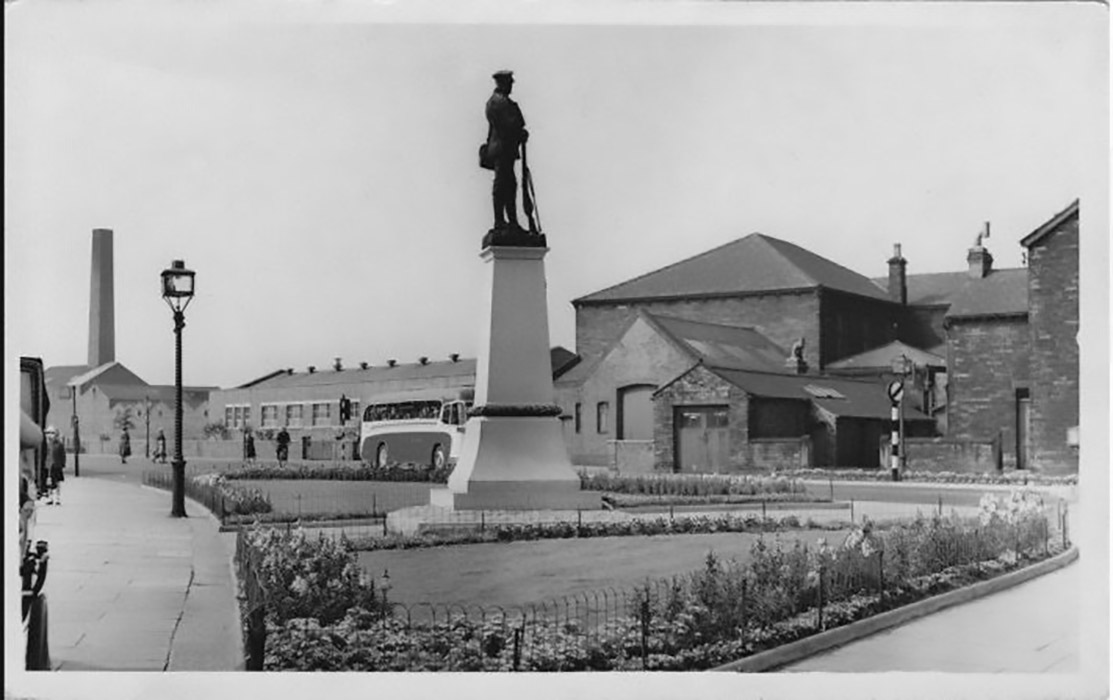 Gedham Mill on the far right (now the location of Ossett Health Village).
Gedham Mill on the far right (now the location of Ossett Health Village).
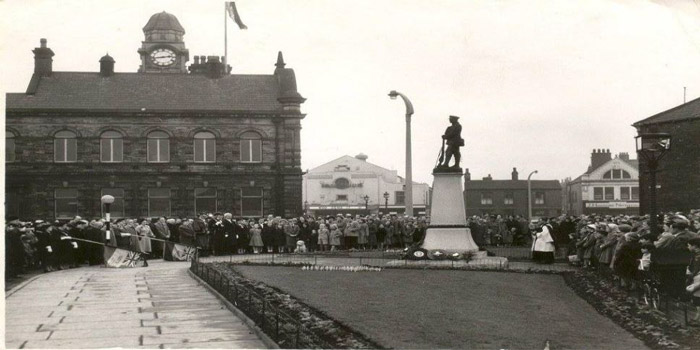 1961 Looking towards the Town Hall with The Palladium Cinema to the rear.
1961 Looking towards the Town Hall with The Palladium Cinema to the rear.
The Memorial was relocated again in 2001 to its present site in the market place facing north-east towards the front of the town hall. The Grade II listing was subject to a Minor Amendment on 29th November 2017 and a second one on 17th May 2021.
On 11 November 2018 the names of 315 fallen of the First World War and 85 fallen of the Second World War were unveiled by children from the 11 Ossett schools, engraved on granite stones laid around the foot of the memorial. To these, a further seven names were added in November 2019; four from the First World War and three from the Second World War.
On 19th November 2020 an Application was made to Historic England for an amendment to the 1988 Listing to incorporate the granite stones bearing the engraved names and legends. The photograph below records the Memorial in 20195
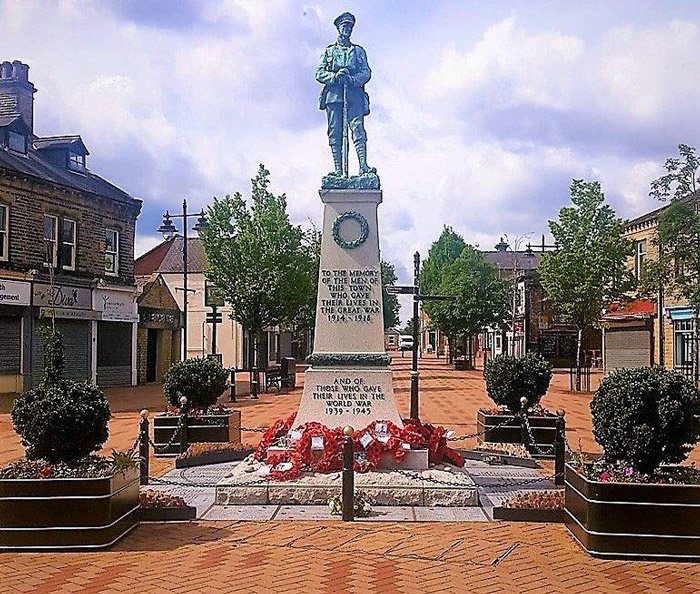
Until November 2018 the War Memorial had borne no names of the Ossett Fallen in WWI & WWII. Instead on the face of the memorial, in bronze letters, there are inscriptions in recognition of their sacrifice in those two conflicts.
In the case of WWI a Commemoration Programme6 was issued for the 1928 Unveiling and Dedication of the Memorial. The Programme recorded the then known names of 230 Ossett men who lost their lives in the 1914-1918 Great War.
No formal record exists for the deaths of those Ossett men and women who gave their lives in the 1939-1945 World War.
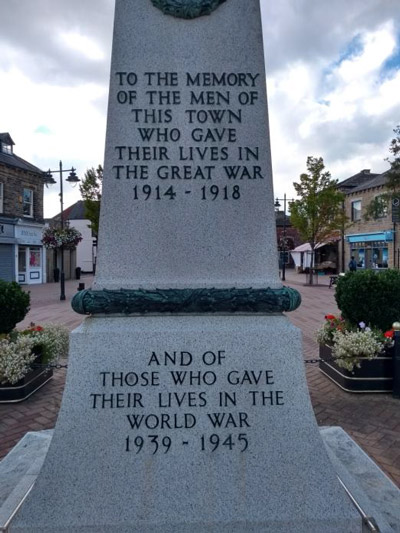
In late summer 2017 The Ossett War Memorial Project was launched by a small group of volunteers intent on marking at the Memorial the names of The Ossett Fallen in the two wars so that these men and women could be remembered in death as they were known in life; by their names. The Project was supported by local ward councillors and in December 2017 an application for permission and funding was submitted to WMDC by the volunteer group. The Application was approved by Wakefield Metropolitan District Council (WMDC) in mid February 2018.
A number of prospective locations and designs were investigated but a decision settled on the names of The Ossett Fallen in WWI & WWII being engraved on granite memorial stones set around the base of the Grade II Listed War Memorial. Tributes and Legends were to be included on two of the 19 memorial stones. Sponsored sand boxes fabricated by a local company were placed at each corner to enable children and adults to place British Legion poppy crosses in memory of the men and women who had served their country in WWI & WWII.
11th November 2018 at 11.am was the 100th anniversary of the 1918 Armistice. On that day at that time the names of The Ossett Fallen who lost their lives in The Great War (1914-1918) and The World War (1939-1945) were unveiled by schoolchildren from the eleven Ossett schools. The commemoration attracted the largest crowd seen since 11th November 1928. 1928 and 2018 had something else in common; a downpour.
The detailed history of the Ossett War Memorial Project from conception in mid 2017 to completion in late 2018 and beyond is yet to be told.
“The idea of the Memorial is to strike a dignified impressive note to the memory of the brave and noble men of Ossett, to be a silent, yet eloquent, testimony of the generations to come, of their proud and wonderful achievements and their lasting glory.
The Memorial consists of a Creetown fine axed granite pedestal, surmounted by a bronze life-sized figure of a soldier. The pedestal stands on a wide rusticated plinth, on which wreaths and memorial tokens may be placed. There are bronze enrichments of a continuous laurel band on the pedestal, and a laurel wreath symbolic of victory above the inscription. The height of the Memorial is seventeen feet8
The pedestal has, in bronze capitals, a legend commemorating the men of Ossett who gave their lives in the Great War 1914-1918. A similar legend at the base commemorates those of Ossett who gave their lives in the World War 1939-1945.
The surmounted life sized bronze figure is of a soldier wearing 1902 Pattern Service Dress and 1908 Pattern Webbing.
The Ossett War Memorial was designed by Mr H Holmes, M.Inst.C.E.I. (Ossett’s Borough Surveyor) and Mr Charles Kendall M.C.,A.R.I.B.A., (Ossett architect). Mr. Kendall had served as a Lieutenant in The Great War during which he had been awarded the Military Cross for gallantry in the face of the enemy.
The life sized bronze figure of the soldier surmounting the Memorial was the work of Worcestor born sculpturer, Mr Robert Lindsay Clark who died in Aberdeenshire in 1926 before the unveiling. It was cast by Walkers of Idle.
The memorial was unveiled in front of a large crowd at 2pm in the afternoon of Armistice Sunday, 11 November 1928, by the Right Honourable the Lord Viscount Lascelles KG DSO. On the day of the ceremony a procession took place, followed by the unveiling, a speech by Lord Lascelles and then the singing of hymns accompanied by the Ossett Military Band.
Research April 2021. Alan Howe
It was a cold and damp, misty morning in the Foret de Compiegne in Picardy, France. It was 11a.m. on November 11th 1918 when it was announced that The Great War was over. The Armistice had been signed.
Meanwhile, on the same day, just 60 miles to the north near Bapaume, British soldiers, including Private Arthur Dews of Ossett cheered at the news that their war had ended and Arthur, aged 24 years, thought of home and his family at 10 Haggs Hill Road, Ossett. They too had heard the news that the Armistice had been signed and the only talk was of Arthur’s safe return.
On this day Arthur Dews was enjoying the peace with four soldier friends when one took off his jacket and hit it against a wall to remove the dust and dirt of conflict. A grenade had found its way into the jacket lining and exploded killing two of the soldiers and wounding another three. Tragically, Arthur was seriously injured and died in France a month later on December 14th 1918.
It was a cold and damp, misty morning in Ossett in mid December 1918. Arthur’s family finally learned that their beloved elder son would never return to them.
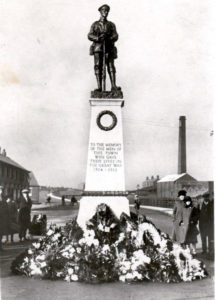 Exactly 10 years later, at 11 am on Sunday 11th November 1928, the Ossett War Memorial was unveiled on the new Kingsway.
Exactly 10 years later, at 11 am on Sunday 11th November 1928, the Ossett War Memorial was unveiled on the new Kingsway.
A Commemoration Programme for the occasion included 230 Ossett men who made the ultimate sacrifice. Although Ossett had had a ten year wait for this Memorial the town wasn’t short of others. Most churches and chapels had their own. In all, Ossett had another 17 memorials upon which were revealed a further 13 Ossett men.
Arthur Dews wasn’t remembered on any of these memorials and recent research of obituaries in local newspapers and Commonwealth War Graves Commission records has identified another 72 Ossett men from WWI who are not remembered on any Ossett memorial. In total, 315 Ossett men lost their lives in the Great War 1914-1918.
In the late 1940’s a second inscription was added to the Memorial. It recognises 87 Ossett men and women who died in WWII. Together with the 315 Ossett Fallen in 1914-1918, Ossett lost 402 of its men and women in these two conflicts. These are The Ossett Fallen.
Ossett War Memorial Kingsway 1928 -1954
In 1954 the Memorial was moved to accommodate changes to the road network and it remained there, still on Kingsway, until 2001 when it was moved to the Market Place. The War Memorial was granted Grade II listed status on May 6th 1988. It is a fitting tribute to those who lost their lives in WWI and WWII but it does not record their names. It recognises the event but not the sacrifice and it says nothing of their number and tells little of their loss. In the absence of a record of those who died how is it possible to know the extent of the sacrifice and suffering of these men, women and children of Ossett who lost their lives, their husbands, their sons and daughters, their brothers and sisters, their fathers and mothers? How is it possible to remember these men and women for the next 100 years if we know not who they were? How can we feel their pain
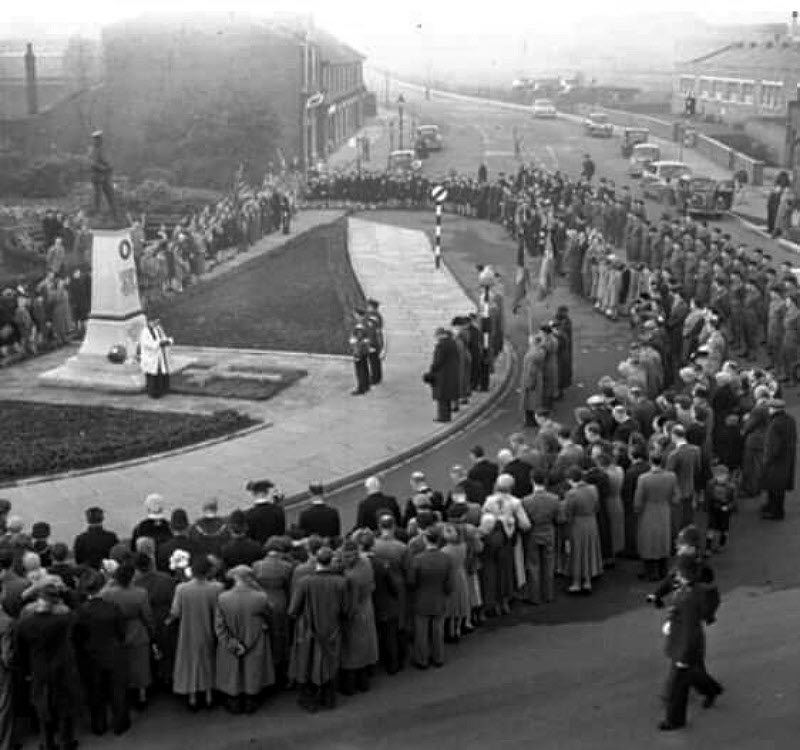 Something must be done. 700 people, the Royal British Legion and local interest groups supported calls for these names to be engraved at the War Memorial, ensuring that it remains the focal point for Remembrance in Ossett, as it has been since 1928.
Something must be done. 700 people, the Royal British Legion and local interest groups supported calls for these names to be engraved at the War Memorial, ensuring that it remains the focal point for Remembrance in Ossett, as it has been since 1928.
Wakefield MDC has approved funding for a proposal devised and submitted by Alan Howe and Pat Howe. Biographies have been researched and written for each of the 402 Ossett men and women who lost their lives in WWI & WWII. These biographies, including that of Arthur Dews, can be viewed at https://ossettheritage.co.uk/local-history/war-memorial/
Remembrance Day 1954 (opposite)
It is the aim of the proposal to see tributes and the names of these 402 men and women engraved on 19 granite memorial stones laid around the base of the War Memorial. Provision will also be made for the placing of small crosses which has become an integral part of Ossett commemorations.
Importantly this will encourage children to continue to play a part and enables others to remember their ancestors from Ossett and beyond. There is a huge appetite for Remembrance within the town. This was demonstrated by the gathering of over 600 people at the War Memorial for the November 2017 commemorations.
This is a chance for our children and our children’s children to understand more about the Ossett Fallen and to carry forward their memory for another 100 years. The objective is completion by 11am on Sunday November 11th 2018. Exactly 100 years after the signing of the Armistice. This is one chance in 100 years.
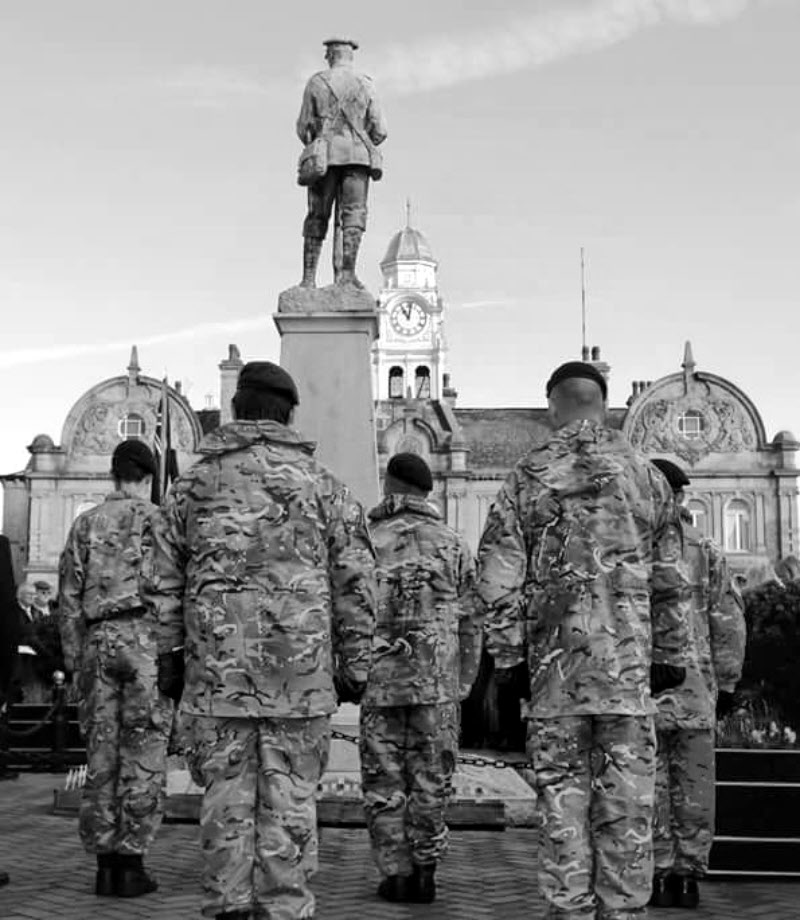 Remembrance Day 11am November 11th 2018
Remembrance Day 11am November 11th 2018
Private Arthur Dews will be there. He is remembered. He has come home.
April 18th 2018 Alan L.Howe
Postscript: This article was designed for and published by local magazines in early 2018 as a means of reaching as wide an audience as possible to garner support for the Ossett War Memorial Project. The article has been amended & updated in 2021 to correct errors and to reflect the addition of another seven names in 2019, bringing the total Ossett Fallen to 409 (319 WWI & 90 WWII).
A History of The Ossett War Memorial Community Centre by Alan Howe
This is a history of the War Memorial Community Centre and the owners and occupiers of the nine roomed dwelling, Prospect House, which once it was.
Located on Prospect Road at the junction with Illingworth Street the Ossett War Memorial Community Centre, first proposed in 1947, was opened for activities in November 1951. It cost almost £9000 and was dedicated by the Lord Bishop of Wakefield, Right Reverend R.P. Wilson on Saturday 17th May 1952 in the presence of a crowd of 400. The ceremony took place in the grounds fronting the building, in glorious weather and was followed by a seven hour programme of indoor and outdoor events.
Others present on the platform included the Mayor and Mayoress of Ossett (Councillor and Mrs. A. Clark), the Deputy Mayor (Alderman J.W. Gill), the Vicar of Ossett (Reverend J. Barton) and Messrs H. Leighton, G. Ball and J.F. Winterburn from the Ossett War Memorial Committee. Acknowledgement was made for the sterling efforts and valuable work behind the scenes of Mr C.H. Lawrence (legal advisor) and Mr Charles Kendall M.C., architect who had also been the co-designer of the Ossett War Memorial which at this time stood at the bottom of Kingsway.
 Mayor Arthur Clark on opening the Centre on 17th May 1952.
Mayor Arthur Clark on opening the Centre on 17th May 1952.
During the Dedication the Bishop said that “if it is not maintained in a manner worthy of its origin and conception, it becomes a rebuke to those who have set it up. Thus we have a heavy responsibility laid upon us”.
On 1st September 1948 the Mayor wrote to Ossett citizens confirming the public meeting view supporting a proposal to build a community centre to perpetuate the memory of our gallant heroes of the late war. He announced that a Subscription Fund had commenced for a minimum total of £7500 adding that it is certain that this figure can easily be surpassed.
Public meetings had been held in 1947 and 1948 to seek opinions and support for the proposal of establishing a War Memorial Community Centre. It was finally decided that a nine roomed dwelling known as Prospect House, set in its own acre of land, would be the ideal location for the Centre to be established. Prospect House had been owned by three generations of the Stringer family since it was built in about 1870. Negotiations for its purchase were well in hand by mid September 1949 and the Government’s Ministry of Education had offered £6,460 towards the estimated cost of £8610 to acquire, refurbish, extend and provide facilities for the purpose of the War Memorial Centre. At that time the owner of the land and property was Herbert Craven Stringer, whose father Herbert and grandfather Joseph had been the previous owners. Herbert junior had long since left Ossett in the early/mid 1930’s.
On 31st December 1949 Herbert Craven Stringer, a bank manager, of Laceby Road, Grimsby agreed to the sale of the then unoccupied Prospect House and outbuildings set upon 5220 square yards (1 acre 5 perches) to the Trustees of the War Memorial Community Centre for the sum of £1,600. The Conveyance and Trust Deed, agreed and signed by Mr. Stringer and the Trustees, permitted the accommodation for private and public functions with catering for development of the arts and literature, music and drama, dances and indoor pleasures and gardens and grounds for outdoor sports. Also generally for the religious social, moral and physical well-being of Ossett residents and the surrounding district by provision for social and physical training and recreation.
 The Centre is now in its 70th year. In the 1950’s it was reputed to be one of the finest in the North; a fitting response to a national movement for such War Memorial Community Centres which was first launched in early 1945.
The Centre is now in its 70th year. In the 1950’s it was reputed to be one of the finest in the North; a fitting response to a national movement for such War Memorial Community Centres which was first launched in early 1945.
 Above: The Ossett Official Handbook 1953. Issued on the authority of The Corporation.
Above: The Ossett Official Handbook 1953. Issued on the authority of The Corporation.
On 16th May 1955 the Mayor of Ossett , Councillor L.R. Smith, officially opened a new tennis court at the
Ossett War Memorial Community Centre. Whilst celebrating the opening the Mayor expressed his disappointment about the small attendance on that day with the youth of the town practically unrepresented. An exhibition match was played on the new court by A. Reader (Yorkshire Doubles Champion) and T. Pickering (Yorkshire Singles Champion).The result of the match is unknown. The cost of the Court was £600 which had been defrayed by the volunteer labour of Centre members and the Ossett and Horbury Round Table. Later that year the Community Centre reported its intention to add a bowling green and two further tennis courts.
It had been practice for many years for the Borough Council to issue an Annual Year Book but it failed to do so in 1969, instead providing Information Sheets. Under the heading Activities In The Borough the entry for the Ossett Memorial Community Centre read;
The work of the Community Centre is very varied, comprehensive of all ages, and of all sections of the community life, and the Centre has played a most part in the community life itself. Each evening the Centre can be seen to be full of activity engendered by one or more of the Centre’s Sections. Activities range from football to whist, and first-aid to “Twist”! (The Modern Dance Group).
Some years ago, a prominent Youth Officer expounded the view that the Centre was doing little towards the Community good, but over the last few years it has proved itself a most virile organisation towards this end. The organisation is headed by the Management Committee, by whom general policy is decided upon and ably administered by a Standing Committee, which meets every month. Each section within the Centre has its own Committee which keeps the heavy burden of small administrative work of the whole Centre spread over as large a number as possible.
The various sections include a Ladies’ Committee. Whist Drive, Old Time and Modern Sequence Dancing, Modern Dancing (for teenagers). Football. Military Band. Snooker and Billiards, and, for the children, a “Saturday Playbox”. In addition however to these various sectionsof its own, the Centre provides accommodation for many other local organisaions. Amongst those taking advantage of these facilities are such organisations as the St. John’s Ambulance Brigade, the Rotary Club, the Chamber of Trade and the Inner Wheel Club etc.
The Centre has, over the past few years, provided social contact for many through its varied activities, and it is the desire of both the Management and Standing Committees that it shall continue to do so, whilst at the same time endeavouring to improve as may be possible existing facilities.
The history of Prospect House(1870-1949)
Prospect House was built about 1870 on a close of meadowland measuring 1 acre 5 perches (5220 square yards) known as Back Lane or Lower Croft, situated at the junction of what was then known as Back Lane (now Prospect Road) and Joseph Illingworth Lane (now Illingworth Street). In 1843 the croft was owned by Mary Illingworth and it remained in her family until about 1864 when it was purchased by Jane Gartside (owner of the Globe Public House on Bank Street) and clothier Joseph Whittaker Ellis.
In 1870 Lower Croft was purchased by Horbury Attorney Joseph Stringer (1826-1897) and by this time a dwelling house and outbuildings had been recently built by Mr. Ellis on the land. Joseph Stringer also owned seven acres of land to the west and immediately adjacent to Lower Croft which had been left by William Lee, landed proprietor, to his daughter Jane Ann Craven Lee who had married Joseph Stringer in 1852.
It’s not certain whether Mr. Stringer retained the dwelling which he acquired in 1870. He may have built another in its place or in addition to that built by Ellis. Whatever the case the dwelling, built by Ellis or Stringer in the early 1870’s, was to become known as Prospect House which became the Ossett Memorial Community Centre in 1949.
Joseph Stringer was living on Ossett Green in 1871 whereas his wife Jane Ann remained living in Horbury. The living arrangements were the same in 1881 by which time Joseph was living on Prospect Road. Joseph was also recorded at Prospect Road in 1891 when he made his Will and he died at Prospect House in September 1897. Joseph Stringer (1826-1897) and his only daughter, Rosa (1860-1917) are buried at Holy Trinity Churchyard.
Following his father’s death in 1897 Prospect House was acquired by his eldest son, estate agent Herbert Stringer (1856-1926). He was living there in 1906 when he made his Will and in 1911 with his wife, Ann (nee Smith) and two children, Maude and Herbert Craven Stringer. Herbert Stringer died at Prospect House in 1926 and his wife Ann (nee Smith), who was left a life interest in the dwelling died in 1929 and hence
Ann Stringer died in 1929 and consequently Herbert Craven Stringer (1894-1969) inherited his father’s real estate, including Prospect House, and the adjacent Apex House.In 1906 Herbert was living at Apex House, and in October 1921 he married German born British subject, Kathleen Jane Atkinson in Wakefield. By 1926 his address was Apex House, Prospect Road as it was in 1930 when he offered Prospect House for sale.
 Yorkshire Post & Leeds Intelligencer 25 January 1930
Yorkshire Post & Leeds Intelligencer 25 January 1930
Prospect House was not sold on the above occasion and shortly thereafter Herbert Craven Stringer moved to Grimsby to take up a job as bank manager. He and his wife were there in 1939 when Herbert, who fought in WWI, volunteered for the A.R.P.
Fittingly it was Herbert Craven Stringer who conveyed the dwelling, Prospect House, outbuildings and land to the Centre in 1949 as a memorial for the men and women of Ossett who made the ultimate sacrifice during the 1939-1945 War.
Private 555499, Herbert Craven Stringer, knew a bit about wars and suffering having himself lived through two wars, serving in both but in particular in WWI with the 16th battalion of the London Regiment. Herbert enlisted in December 1915, embarked for France in 1916 and was discharged on the grounds of wounds or sickness on 7th July 1919 when he was awarded a Silver Badge to signify his service and that his disability was caused by his service to the country.
Herbert Craven Stringer made his Will in June 1950 and died at the General Hospital Poole, Dorset on 20th May 1969. He was 74 years of age.
By 1949 three generations of the Stringer family had owned the dwelling known as Prospect House which was to become the Ossett War Memorial Community Centre. The family’s tenure of Prospect House had ended after 79 years and two World Wars. A new era began on 31st December 1949, when Herbert Craven Stringer signed the Conveyance & Trust Deed which saw Prospect House and 5220 sq.yds of land (1 acre 5 perches) sold to the Trustees of the War Memorial Community Centre.
The Well being Garden 2021
The 1949 Trust Deed permits the Ossett War Memorial Community Centre to encourage physical well-being…. by the provision for social and physical training and recreation. In 2019 the Centre was successful in obtaining funding from WMDC to develop and build a Sensory Garden for use by centre users and the general community. Interrupted by the pandemic for much of 2020 the Well being Garden at the Community Centre was officially opened by the Lord Mayor of Wakefield, Councillor Tracey Austin supported by the Leader of Council, Councillor Denise Jeffery on Sunday 3rd October 2021. The chairman of the Centre offered thanks to Julia Roebuck and her team for their sterling effort and expertise in creating the Garden.

Well being Garden at rear of the Centre 2021

Opening of Well being Garden Sunday 3rd October 2021
Alan Howe September 2021
THE OSSETT FALLEN
OSSETT WAR MEMORIAL PROJECT 2017-2018
HOW IT HAPPENED & WHAT IT DID Summary by Alan & Pat Howe
This is the untold history of the Ossett War Memorial Project 2018; a Project which delivered its objective. It is November 2021, three years after the engraving and unveiling of the names of The Ossett Fallen on 11th November 2018, a whole century to the day after the 1918 Armistice was signed to end The Great War 1914- 1918.
The objective was to ensure that, by 11th November 2018, the 100th anniversary of the signing of the 1918 Armistice, the names of the Ossett Fallen in WWI & WWII had a home in the centre of the town so that current and future generations knew their names and their sacrifice.
The seed of the concept was planted in September 2017 when a lady called Dorothy Wainwright mentioned to me her understanding that some other localities had sought, with success, funding for their war memorial and fallen. We knew Dorothy for the files of the Ossett Fallen which she had created from press cuttings and other sources in the time she worked at Ossett Library. Her work was the basis for the research and writing of the biographies of those men and women.
The Grade II Listed Ossett’s War Memorial was first unveiled in 1928 but it carried only generic inscriptions of tributes to the servicemen who perished in WWI & WWII. The memorial did not tell the names of those men and women.
A small group of four, which dwindled to two, was established when it was learned that Wakefield Council (WMDC) had a funding scheme which might provide the financial resources to make the concept real. The group, which was subsequently assisted by a new third member, became known as The War Memorial Project 2017-2018.
During the life of the Project research continued apace to seek out more Ossett Fallen. Andrea Hartley has a passion for the Ossett Fallen helping to discover some of the twenty additional names added to the total we had when we began this journey in summer 2017. Andrea had become a stalwart member of the team assisting and contributing when and wherever she could. A great many others who were called upon also shared their knowledge and expertise on specific issues and we thank them all in the knowledge that were they not able to support us then the Project wouldn’t have been a success.
Where To Begin
We began by consulting the community and local interest groups to determine their views about where the names of the 402 should be remembered. The vast majority expressed a preference for a location within the Market Place and, in particular, at the War Memorial which had been the centre of remembrance since it was first erected in 1928. (see below)
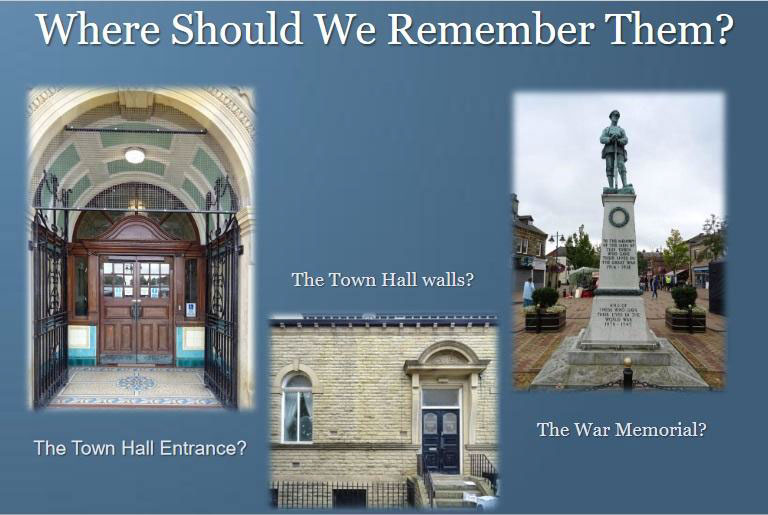
A key issue in the approval process was that the Memorial was Grade II Listed and situated in a Conservation Area. WMDC relied to a significant extent on the War Memorial Trust for advice and it became clear that, like us, the Trust wanted to preserve the integrity of the 1928 structure. In any event the concave faces of the Memorial presented all kinds of problems for potential metal plaque makers.
Further discussions with Planning and the Trust left only one option; the names would need to be placed, in one way or another, at and not on, the War Memorial in the Market Place. We set about designing how this might be possible considering stone planters at each corner bearing the names or the creation of a low wall with or without seating on three sides of the memorial. Have considered these ideas they were binned in favour of granite paviours set around at ground level, but not touching, the War Memorial. In that way neither Listed Building nor Planning consent would be required and concerns about the intrusive nature of those ideas were satisfied.
The details of how it might look, costings, architectural and structural matters and so on remained to be sorted before an application to WMDC could be made for the proposal and its funding. The submission was supported by the three ward councillors, Councillors Angela Taylor, Nick Farmer and Lynn Masterman (the Lead Councillor on the Project).The Application was made on 6th December 2017 and approved in full in mid February 2018 and WMDC set aside £10,000 to cover the estimated cost of the proposal. The final cost was well within that sum.
The final concept was agreed with the chosen mason. There would be nineteen granite stones, of which thirteen would bear the names of the 402 (now 409) Ossett Fallen. Four were corner stones each bearing an engraving of a Yorkshire Rose; a locally fabricated and a sponsored sand box would stand at each corner. The remaining two stones would be engraved with tributes to the Fallen and others who had served the country in conflicts.
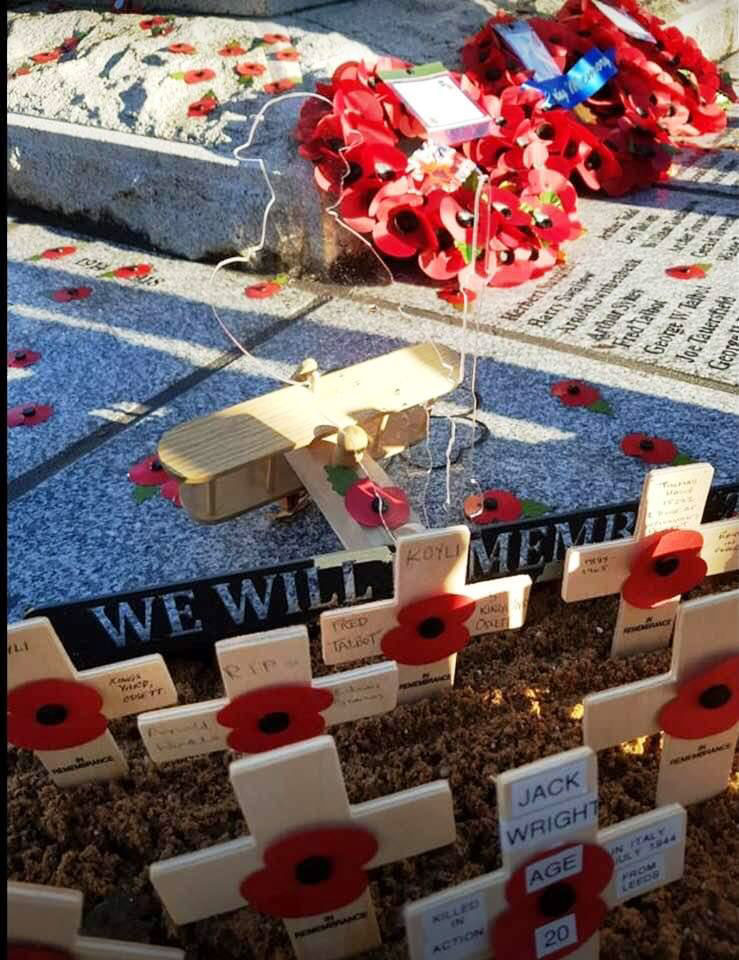
The beauty of the concept is that from almost every position in the market place you see only what you saw pre November 2018; the Ossett War Memorial as it was in 1928, without names. The Memorial’s integrity was respected and protected. As you get closer you read the long held generic inscriptions of 1928 and the late 1940’s and, most importantly, you can now see and read the names of the men and women who lost their lives so that we might live ours in freedom. People no longer simply walk past as if the Memorial wasn’t there; instead they stop and, I hope, they think and remember. In that sense the names are There But Not There.
The theme continued. Silhouette courtesy Jack Wild.
The Chinese Connection
The bespoke granite memorial stones, complementing the 1928 granite Memorial, could only be sourced from China and they were ordered on 5th April 2018, just five days beyond the Project’s timetable date. The memorial stones were to be shipped, by sea, from China to the UK and had a 13 week lead in time so that they should be with the chosen mason by 30th June 2018.
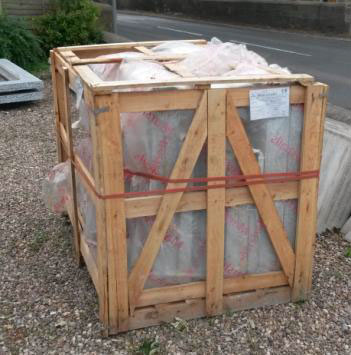 The stones, ordered by the supplier to WMDC, arrived with the mason within date but two of the nineteen stones were missing and another seven arrived in a damaged state. Contingency within the set timetable would just allow 13 weeks or so for a replacement shipping cargo but there was little confidence that a second shipping would be in any better a condition than the first. There wasn’t time for a third shipping should that be the case and so, instead of shipping, the stone supplier, Marshall’s PLC, agreed to fly what was required from China to the UK.
The stones, ordered by the supplier to WMDC, arrived with the mason within date but two of the nineteen stones were missing and another seven arrived in a damaged state. Contingency within the set timetable would just allow 13 weeks or so for a replacement shipping cargo but there was little confidence that a second shipping would be in any better a condition than the first. There wasn’t time for a third shipping should that be the case and so, instead of shipping, the stone supplier, Marshall’s PLC, agreed to fly what was required from China to the UK.
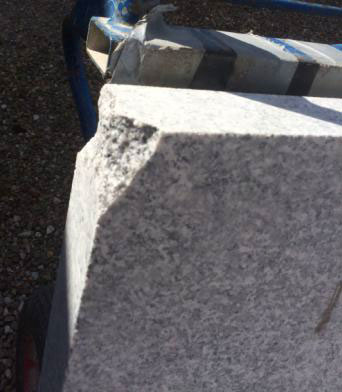 Marshalls also employed their own masons to salvage what they could from the original shipping but unfortunately their masons wrongly cut one of the stones and Marshalls had to commission a second flight from China. The full and proper requirement was with WMDC’s chosen mason by 31st August 2018; two months later than the programme date.
Marshalls also employed their own masons to salvage what they could from the original shipping but unfortunately their masons wrongly cut one of the stones and Marshalls had to commission a second flight from China. The full and proper requirement was with WMDC’s chosen mason by 31st August 2018; two months later than the programme date.
Shipped from China; Poor packaging, 2 stones missing & 7 damaged.
The Final Curtain
Instead of two months to engrave almost 6000 characters the mason had only one month. He delivered the nineteen engraved memorial stones to the War Memorial site by the end of September 2018. We were more or less back on course after a scary July and August when we were convinced the Project would collapse.
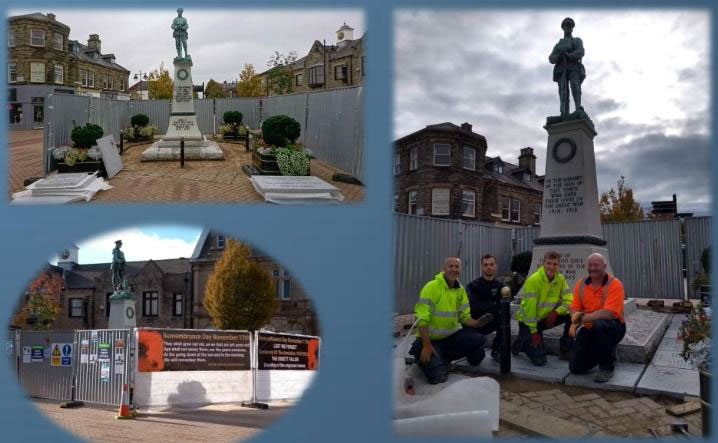
October 2018 ENGIE Team who undertook groundwork and the laying of the memorial stones
The Memorial became a construction site with high level hoarding to enable ENGIE (the Council’s contractor) to do the groundwork and lay the stones; the hoarding remained so the engraved stones would be unseen by the public until 11th November 2018. ENGIE began on 15th October 2018 and completed by 19th October. Spurr Fabrication Ltd, sponsors, designers and fabricators of the bespoke sand boxes delivered and fixed them in place on Monday 5th November 2018.
All the while Ossett people and local interest groups were kept informed with regular updates.
In summer we had canvassed Ossett’s eleven schools for their support and to discuss our proposals that Ossett’s children record their voices speaking the names of the Ossett Fallen and unveiling their names on 11th November 2018. The schools and the children embraced the concept.
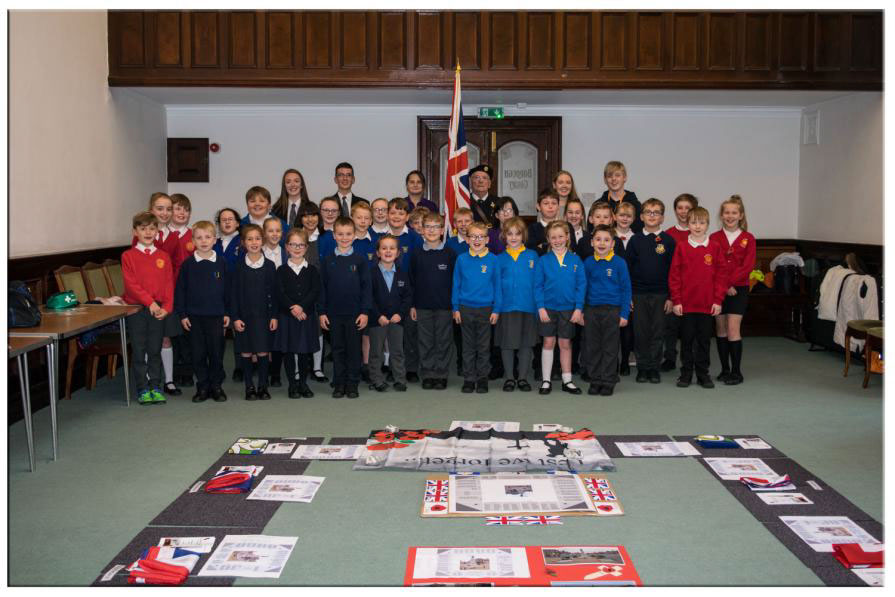 23rd October 2018 School children from the eleven Ossett schools gather at the Town Hall to rehearse for 11th November 2018 with Royal British Legion Standard Bearer, Harry Wakefield.
23rd October 2018 School children from the eleven Ossett schools gather at the Town Hall to rehearse for 11th November 2018 with Royal British Legion Standard Bearer, Harry Wakefield.
On The Day. Sunday 11th November 2018
Across the United Kingdom and the rest of the world at 6 a.m. on this morning many a Lone Piper was to play “When The Battle is Over” to mark the signing of the truce on 11th November 1918. Ossett was no different and in another immensely moving ceremony the Lone Piper, Mr David Holdsworth, stood alone on the Town Hall steps and played “ When The Battle Is Over” to a substantial early morning gathering. (see below)
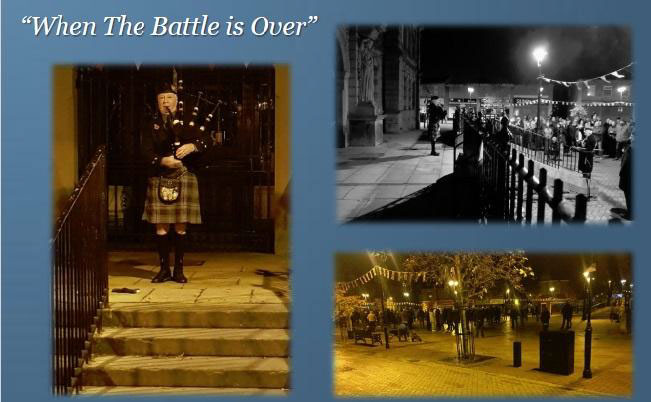
As the sun came up ENGIE removed the hoardings from the Memorial which was dressed with Royal British Legion poppies. The memorial stones were covered by eleven Union standards and other emblems including the Yorkshire Rose and Poppies in readiness for the service.
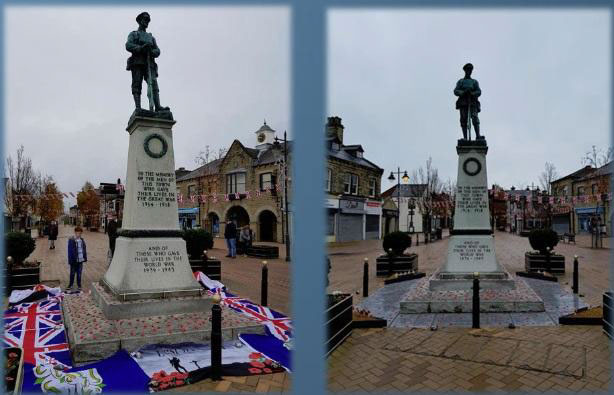
The crowds, estimated at 1500 – 2000, gathered (see below) and the heavens opened just as they had ninety years ago at the unveiling of the Ossett War Memorial on Sunday 11th November 1928. The only difference between 1928 and 2018 was the colour of the umbrellas and the presence in 2018 of BBC television who were recording coverage for their later news reports.
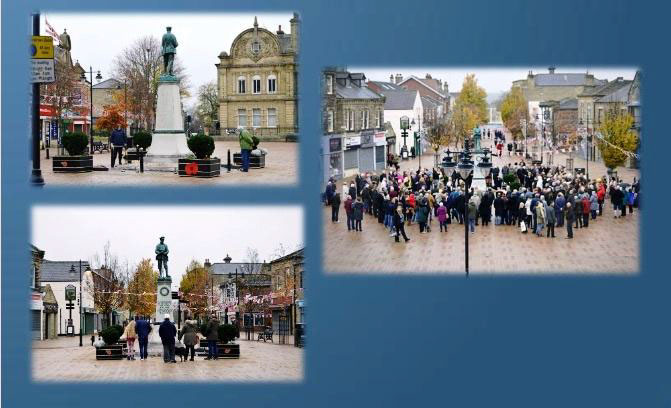
From 10.45 a.m. the Royal British Legion’s local branch Vice Chairman, Parade Master and Ossett legend, Peter Waters, conducted the proceedings with his usual panache which is now sadly missed. The service ended with the children unveiling the names of the Ossett Fallen of WWI & WWII, followed by the two minutes silence at 11 a.m.
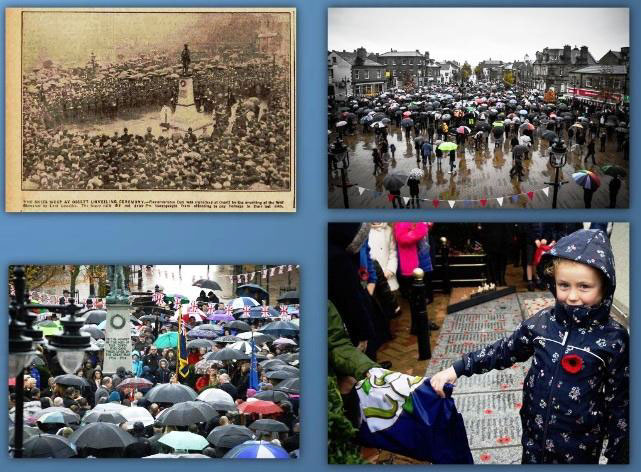
The afternoon Service of Remembrance at Holy Trinity was equally well attended. Those attending left at the end of the service to the recorded voices of Ossett children speaking the names of the 402 Ossett Fallen comprising 315 men who died in WWI and 87 men and women who were lost in WWII. Most of those present joined the usual Procession from the Church to the Market Place arriving to the echo of the names of the Ossett Fallen. A Service of Remembrance and Dedication was held before the laying of wreaths at the Ossett War Memorial.
The importance of the Commemoration demanded photographic coverage at the highest level. We approached a number and all enthusiastically responded and offered their services free of charge. Each had a “brief” and a position of sorts……whether it was from a Town Hall window, a cherry picker, close up (but busy) or free to roam, the collection of photographs from the morning and afternoon was stunning. Photographers on the day included Phillip Smithson, Robert Anthony James Ingham, Neville Ashby, Kenny Smith, Andy Steer and Paul Crilley. Kenny Smith also produced a DVD of the Commemoration and Presentations to the children.
They Thought It Was All Over
Ossett children’s contributions to the 2018 Commemoration by the speaking and unveiling of the names of the Ossett Fallen set us thinking that we should mark their contribution in some way. The Chairman of the local branch of the Royal British Legion, Mr. Malcolm Patterson, proposed that they be invited to a Presentation by the Deputy Lord Lieutenant of West Yorkshire , Mr. Mark Skipper.
Arrangements were made for the Deputy Lord Lieutenant to meet and thank the children from the eleven Ossett Schools who participated in the recording of their voices speaking the names of the 402 Ossett Fallen from two world wars. Another group from the same schools were charged with the unveiling of the names of the Ossett Fallen at the War Memorial in the Market Place moments before the 11th hour of the 11th day of the 11th month in 2018. They too were invited to meet with the Deputy Lord Lieutenant.
The Presentation was held at 1p.m. on Friday 30th November 2018 in the Magistrates’ Court Room at Ossett Town Hall. The Royal British Legion, whose initiative this was, were represented by the Chairman, Vice Chairman /Parade Master and Standard Bearer, respectively Mr. Malcolm Patterson, Mr Peter Waters and Mr. Harry Wakefield.
Each of the children from each of the schools were awarded a British Legion Certificate of Appreciation for their contributions and the Deputy Lord Lieutenant presented each child with the Certificate, a commemorative pin, a wooden poppy cross, a DVD of the event and an emblem in memory of the day.
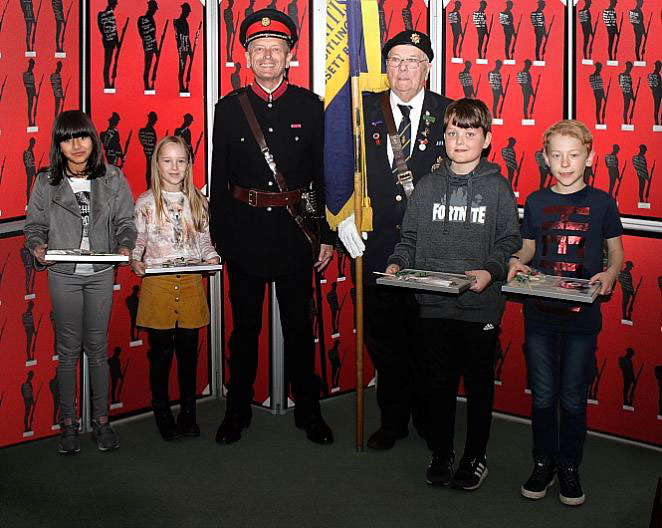
Deputy Lord Lieutenant & Holy Trinity children
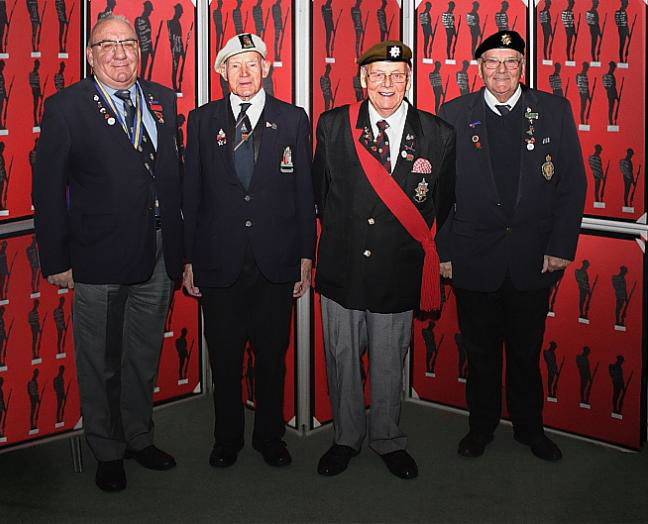
Royal British Legion with John Hirst 2nd left Malcolm Patterson, Peter Waters, Harry Wakefield
And so, like all good things the War Memorial Project 2017-2018 came to an end. Its work completed. For those who had a part in the Project there were two key achievements. The first was that it had attempted what no other generation in 100 years had attempted. Secondly that it achieved what it set out to achieve.
In the making of that success a new generation had embraced the old. The future was looking after the past. For that we thank the heroes of the War Memorial Project 2017-2018; Ossett’s children.
Ossett Heritage & the Ossett Fallen Roll Of Honour
There were so many wonderful people that we called upon to help with the War Memorial Project 2018 that three years on we fear our memories may let us down. We hope though that we have included all of those who helped; if we do miss anyone from the list it will be either our forgetfulness or it was deliberate. The list is in no particular order except alphabetical. Our heartfelt thanks to all of you for your support. Thank you.
Austerfield Flooring Ltd, Dean and Louise. Sponsors.
Burnett, Kelly Education Ossett Community Trust Coordination Officer
Build Ossett Better, Bev Riley, John Whiteman.
Councillors Nick Farmer, Angela Taylor and former councillor, Lynn Masterman
Deputy Lord Lieutenant, Mr. Mark Skipper
ENGIE Dale Potter, David Harper, Fox Elliott, Kieran Guiry, Philip Holmes.
Hartley, Andrea & Kevin
Hirst, John, Merchant Navy (ret’d)
Holdsworth, David, The Lone Piper
James Burrell Building Merchants, Steve Kellett
Lancaster Memorials Ltd, Ackworth, David Hiorns
Lifterz, Andy Legge
Marshalls PLC, Paul Thwaites
Ossett School heads and liaison officers
Ossett schoolchildren who took part.
Ossett Library staff
Spurr Fabrications Ltd, Richard Spurr. Sponsers
Photographers on the day, Phillip Smithson, Robert Anthony James Ingham, Neville Ashby, Kenny Smith, Andy Steer, Paul Crilley.
Photographers for other occasions Kenny Smith & Robert Anthony James Ingham Royal British Legion, Malcolm Patterson, Peter Waters, Harry Wakefield. Shackleton, Anthea, Reverend
Wainwright, Dorothy
Wild, Emma, Ashley and Jack
Williams, Nigel Holy Trinity Primary School, Media Coordinator
WMDC officers Helen Bower, Louise Bragan, Rob Holt, Ian Firth, Karen Morrell, Helen Purvis, Andy Schoolar, Amanda Scott, Andrew Woodhead. (last but by no means least)
Pat Monteagle Howe and Alan Howe November 2021